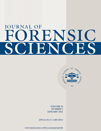Comparison of Age Estimation in Japanese and Scandinavian Teeth Using Amino Acid Racemization*
Supported by the National Institute on Drug Abuse, Contract No. N01DA-5-7746. The content is solely the responsibility of the authors and does not necessarily represent the official views of the National Institutes of Health.
Abstract
Abstract: Racemization method is currently considered to be one of the most accurate methods for age estimation. There are many factors that affect racemization reaction velocities. We investigated ethnic differences in the racemization reaction velocities between Japanese and Scandinavian teeth. After a heating experiment, the Arrhenius equation was used to obtain a rate constant (k). Both groups presented almost identical velocities, indicating that there was no difference in the tooth racemization reaction between the two groups. However, because 14 of the 18 Scandinavian teeth had multiple roots, it is possible that accurate racemization rates of the teeth themselves were not reflected in the results. These findings reconfirm that the type of tooth selected is extremely important when evaluating age by racemization.




